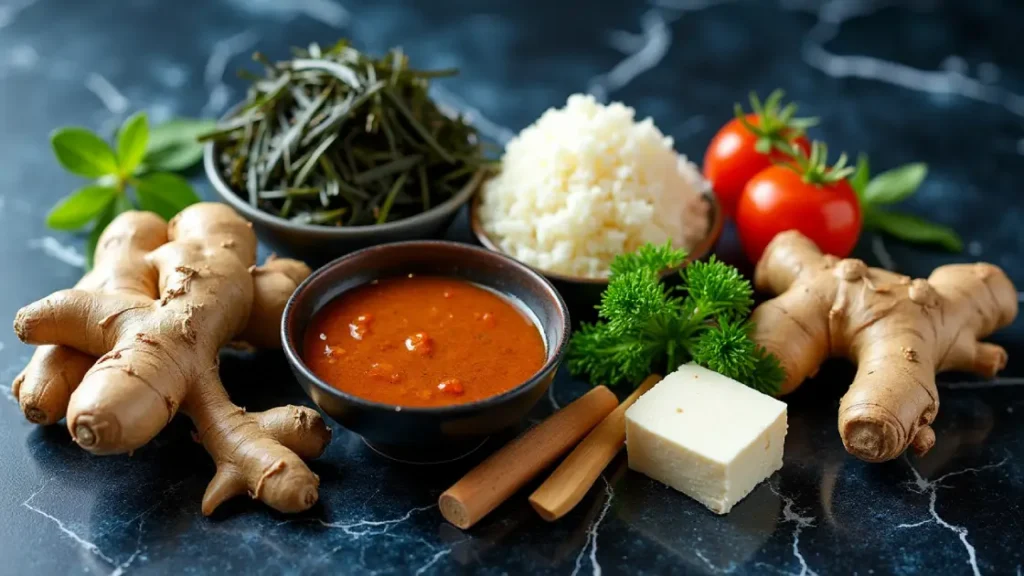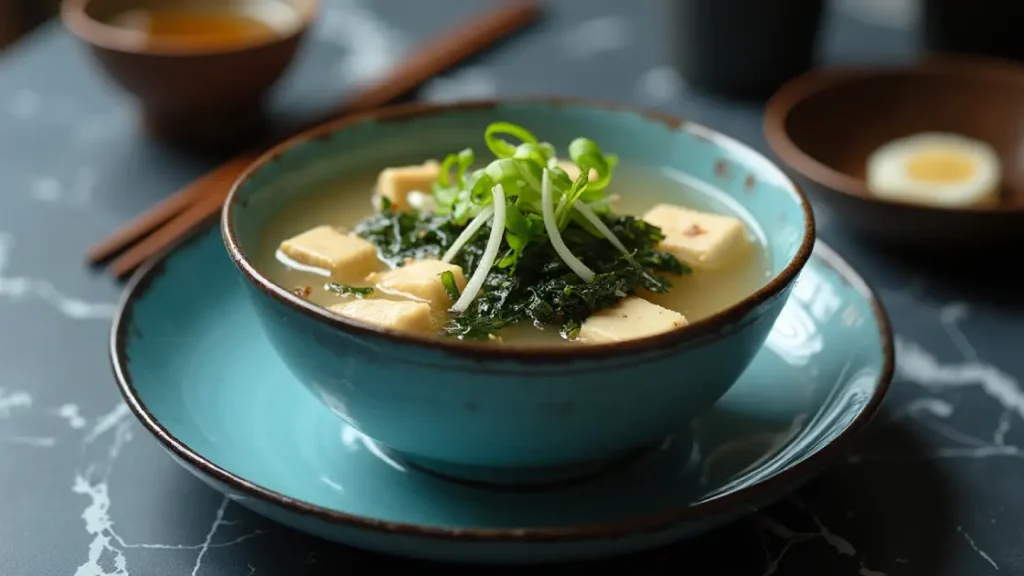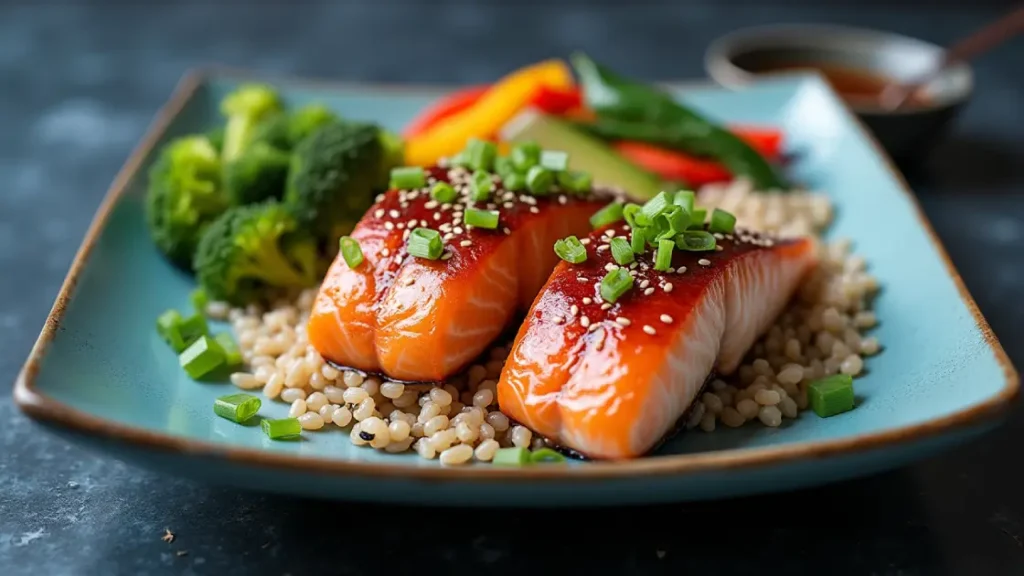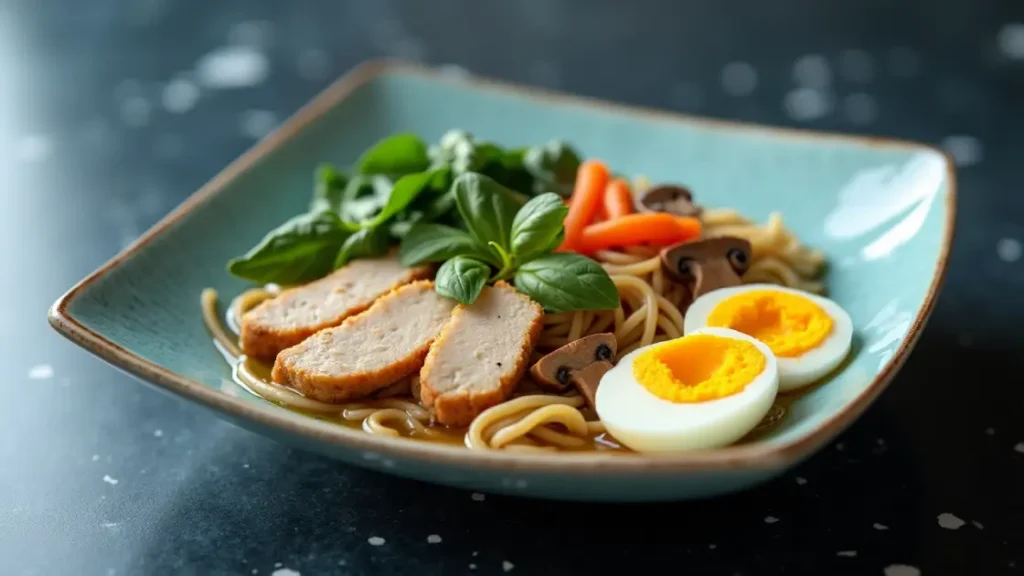Table of Contents

Introduction: Discover the Best Easy Japanese Recipes for Healthy and Flavorful Meals at Home
Imagine creating flavorful, nutrient-packed Japanese meals in your own kitchen without spending hours prepping. Japanese cuisine is renowned for its balance, using fresh ingredients that promote longevity and overall wellness. If you’ve ever wanted to bring these wholesome flavors into your home, you’re in the right place! In this guide, you’ll discover easy Japanese recipes that are both healthy and simple to prepare. Whether you’re looking for low-calorie Japanese dishes, healthy Japanese cooking techniques, or nutritious Japanese meals, this article has got you covered.
Why Choose Healthy and Easy Japanese Recipes?
- Balanced Nutrition: Did you know that Japanese cuisine is built on a perfect balance of protein, fiber, and healthy fats? That means you get a meal that’s both delicious and nutritious!
- Quick Preparation: Many recipes take under 30 minutes to make.
- Wholesome Ingredients: Fresh vegetables, lean proteins, and nutrient-rich grains.
- Easy Japanese Comfort Food: Enjoy hearty meals that nourish both body and soul.
Essential Ingredients for Healthy Japanese Cooking

Before diving into these easy Japanese recipes, stock your kitchen with these key ingredients:
| Ingredient | Health Benefits |
|---|---|
| Miso Paste | Rich in probiotics, supports gut health |
| Seaweed | High in iodine and antioxidants |
| Tofu | Excellent plant-based protein source |
| Fresh Ginger | Aids digestion and reduces inflammation |
| Fresh Ginger | Adds umami flavor without excess salt |
| Fresh Ginger | Whole grain with fiber for sustained energy |
1. Delicious Low-Calorie Japanese Dishes That Won’t Weigh You Down
Miso Soup with Tofu and Seaweed

A classic Japanese staple, this miso soup is light yet packed with essential nutrients. It’s an excellent choice for a low-calorie, satisfying meal that supports gut health and overall wellness.
Ingredients:
| Ingredient | Quantity |
| Water | 4 cups |
| Miso Paste | 2 tbsp |
| Tofu (cubed) | 1/2 cup |
| Seaweed | 1/4 cup |
| Green Onion | 1, sliced |
| Soy Sauce (Low-Sodium) | 1 tsp |
- Water:
Water is the base for this soup and helps keep you hydrated. Proper hydration is essential for digestion, circulation, and maintaining healthy skin. Additionally, water plays a vital role in detoxification and nutrient absorption in the body. - Miso Paste:
Miso paste is made from fermented soybeans and is rich in probiotics, which promote a healthy gut microbiome. A balanced gut microbiome is essential for digestion, immune function, and overall health. Miso is also a good source of protein and fiber, which help maintain satiety and support digestion. The fermentation process also produces beneficial enzymes that assist in nutrient absorption and improve gut health. - Tofu:
Tofu is an excellent source of plant-based protein, which is important for muscle repair, growth, and overall tissue health. It contains all nine essential amino acids, making it a complete protein. Tofu is also rich in iron, which is essential for oxygen transport in the blood and helps prevent anemia. Additionally, tofu contains calcium, which supports strong bones and dental health, and magnesium, which helps with muscle function and relaxation. - Seaweed:
Seaweed is a nutrient-dense food that provides a variety of health benefits. It is an excellent source of iodine, which is crucial for thyroid function and the production of thyroid hormones that regulate metabolism. Seaweed also contains antioxidants, including flavonoids and carotenoids, which help fight oxidative stress and reduce inflammation in the body. It is also a rich source of fiber, which promotes digestion and helps regulate cholesterol levels. - Green Onion:
Green onions (or scallions) are rich in Vitamin K, which supports bone health and blood clotting. They also provide Vitamin C, an antioxidant that supports the immune system and promotes healthy skin. Green onions contain flavonoids, which have anti-inflammatory and antioxidant properties, contributing to overall health. - Soy Sauce (Low-Sodium):
Soy sauce adds umami flavor to the soup without adding excessive sodium. By using a low-sodium variety, you can enjoy the savory taste of soy sauce while minimizing sodium intake. Soy sauce contains antioxidants from fermented soybeans that help reduce inflammation and oxidative stress. Additionally, it provides a source of protein and minerals like manganese and copper.
Instructions:
- Heat water in a pot until hot but not boiling.
- Dissolve miso paste in a small amount of warm water before adding it to the pot.
- Add tofu, seaweed, and soy sauce to the pot.
- Simmer for 3-5 minutes. Garnish with green onions and serve warm.
Health Benefits:
- Calories: ~80 per serving
- Probiotics: Miso paste promotes gut health by supporting the growth of beneficial bacteria in the digestive system, which aids in digestion and immune function.
- Plant-Based Protein: Tofu provides a high-quality protein source, important for muscle repair, immune support, and overall tissue health.
- Iodine and Antioxidants: Seaweed is rich in iodine for thyroid function and contains antioxidants to help fight inflammation and oxidative stress.
- Vitamins and Fiber: Green onions and seaweed offer essential vitamins like Vitamin C and Vitamin K, while fiber from tofu and seaweed promotes healthy digestion and regulates cholesterol levels.
This light yet nutrient-packed miso soup offers a delicious balance of protein, fiber, and probiotics, making it a perfect low-calorie, gut-friendly meal.
2. Healthy and Easy Japanese Recipes: Nutritious Meals for a Balanced Diet
Teriyaki Salmon with Steamed Vegetables

This protein-rich dish combines the omega-3 goodness of salmon with vibrant, nutrient-packed vegetables, offering a wholesome meal that supports overall health and well-being.
Ingredients:
| Ingredient | Quantity |
| Salmon Fillets | 2 |
| Low-Sodium Teriyaki Sauce | 2 tbsp |
| Steamed Broccoli | 1 cup |
| Sliced Bell Peppers | 1/2 cup |
| Brown Rice | 1/2 cup |
- Salmon Fillets:
Salmon is an excellent source of omega-3 fatty acids, which are essential for heart health. Omega-3s help reduce inflammation, lower blood pressure, and decrease the risk of heart disease. Additionally, salmon is rich in protein, which supports muscle growth and tissue repair. It also contains Vitamin D, which is important for bone health and immune function. - Low-Sodium Teriyaki Sauce:
Teriyaki sauce adds umami flavor without overwhelming the dish with excess sodium. Using a low-sodium version helps control sodium intake, which is crucial for maintaining healthy blood pressure. Teriyaki sauce also contains antioxidants from ingredients like soy sauce and mirin, which help combat oxidative stress and support overall health. - Steamed Broccoli:
Broccoli is packed with Vitamin C, which boosts the immune system and helps the body absorb iron more efficiently. It also contains Vitamin K, which supports bone health and blood clotting. Broccoli is rich in fiber, which aids digestion and helps regulate blood sugar levels. Additionally, it contains sulforaphane, a compound known for its cancer-fighting properties. - Sliced Bell Peppers:
Bell peppers, especially red and yellow varieties, are high in Vitamin C—even more so than oranges. Vitamin C is a powerful antioxidant that helps protect against cell damage and supports skin health. Bell peppers are also a good source of Vitamin A, which is essential for maintaining good vision and immune health. They provide fiber, which contributes to digestive health and helps control cholesterol levels. - Brown Rice:
Brown rice is a whole grain that retains its bran and germ, making it an excellent source of fiber. The fiber in brown rice promotes healthy digestion and helps maintain stable blood sugar levels. Brown rice is also rich in magnesium, which supports muscle function and bone health. Unlike white rice, brown rice has a lower glycemic index, making it a healthier choice for controlling blood sugar levels.
Instructions:
- Marinate salmon fillets in teriyaki sauce for 15 minutes.
- Grill or pan-sear salmon for 3-4 minutes per side, until cooked through.
- Steam broccoli and bell peppers while the salmon is cooking.
- Serve the salmon and vegetables with a portion of brown rice for a complete, balanced meal.
Health Benefits:
- Calories: ~350 per serving
- Omega-3 Fatty Acids: Found in salmon, omega-3s support heart health, reduce inflammation, and improve brain function.
- Vitamins A, C, and Fiber: The combination of bell peppers and broccoli provides essential vitamins for immune health, vision, and skin health. The fiber content aids digestion and helps control blood sugar.
- Protein: Salmon provides high-quality protein, which is vital for muscle repair, growth, and immune function.
- Antioxidants: The antioxidants in vegetables and teriyaki sauce help combat oxidative stress, supporting overall health and longevity.
These healthy and easy Japanese recipes provide a perfect balance of nutrients, flavors, and simplicity for a well-rounded and nourishing diet.
3. Easy Japanese Comfort Food Without the Guilt
Healthy Chicken and Vegetable Ramen

Enjoy a warm, comforting bowl of ramen without the heavy calories of traditional versions. This recipe is not only delicious but also packed with health benefits from its natural ingredients.
Ingredients:
| Ingredient | Quantity |
| Low-Sodium Chicken Broth | 4 cups |
| Boneless, Skinless Chicken Breast (sliced) | 1 |
| Mixed Vegetables (Carrots, Mushrooms, Spinach) | 1 cup |
| Whole Wheat Ramen Noodles | 1 pack |
| Boiled Egg | 1 |
- Low-Sodium Chicken Broth:
Chicken broth is a great way to add flavor without adding too much sodium. Using low-sodium broth helps maintain healthy blood pressure levels and reduces the risk of cardiovascular diseases. It’s also hydrating and provides a rich base for the soup. - Boneless, Skinless Chicken Breast:
Chicken breast is a high-quality source of protein that helps build muscle tissue and supports cell growth. It’s low in saturated fat, making it an excellent choice for those following a healthy diet. Protein also plays a critical role in boosting the immune system and promoting recovery after physical activity. - Mixed Vegetables (Carrots, Mushrooms, Spinach):
- Carrots: Rich in Vitamin A, carrots help support eye health and reduce the risk of age-related eye diseases such as macular degeneration. Carrots are also packed with antioxidants that fight free radicals and support skin health.
- Mushrooms: Mushrooms are high in Vitamin D, which promotes bone health and aids in calcium absorption. They also contain polysaccharides, which support immune health and reduce inflammation.
- Spinach: Spinach is one of the best natural sources of Vitamin K, which supports bone health and helps increase bone mineral density. It also contains iron, which boosts energy levels and aids in the transport of oxygen to cells.
- Whole Wheat Ramen Noodles:
Whole wheat ramen noodles are a great source of fiber, which aids digestion and helps maintain stable blood sugar levels. Fiber also plays a role in reducing bad LDL cholesterol levels, promoting heart health. - Boiled Egg:
Eggs are a complete source of high-quality protein and essential vitamins and minerals, including Vitamin B12 and Folate. They support the nervous system and help reduce the risk of heart disease by providing healthy fats.
Instructions:
- Heat the chicken broth in a pot over medium heat until it begins to simmer.
- Add the sliced chicken breast and cook for about 5-7 minutes until fully cooked.
- Stir in the mixed vegetables and let them cook for another 3-4 minutes until tender.
- Cook the whole wheat ramen noodles separately according to the package instructions, then drain and add them to the pot.
- Slice the boiled egg in half and place it on top of the ramen.
- Serve hot and enjoy your healthy, comforting bowl of ramen!
Health Benefits:
- Calories: ~400 per serving
- Protein: An excellent source of protein that helps build muscles and tissues.
- Fiber: The vegetables and whole wheat noodles provide essential fiber for digestive health and gut function.
- Vitamins and Minerals: This dish is rich in a variety of vitamins like Vitamin A, C, and K, as well as essential minerals like iron and calcium.
- Antioxidants: The antioxidants in mushrooms, carrots, and spinach help reduce inflammation and support immune health.
This section offers comforting yet guilt-free Japanese dishes that are both delicious and packed with health benefits.
Healthy Swaps for Easy Japanese Recipes: Can I Substitute Ingredients?
Absolutely! Here are some healthy swaps to make your meals even more nutritious:
- Whole Wheat Noodles → Zucchini Noodles: Swap whole wheat ramen noodles with zucchini noodles to reduce carbohydrates and increase vegetable intake. Zucchini noodles are a low-calorie, fiber-rich option that can help keep you fuller for longer.
- Chicken → Tofu: For those following a plant-based diet, tofu is a great substitute for chicken. It’s a high-quality, plant-based protein that’s rich in iron and calcium, making it an excellent choice for vegetarians and vegans.
- Soy Sauce → Coconut Aminos: If you’re looking to lower your sodium intake, consider using coconut aminos. It’s a naturally gluten-free alternative with less sodium but still packs that delicious umami flavor.
- Brown Rice → Quinoa: Substitute brown rice with quinoa for a gluten-free option that’s higher in protein and fiber, providing more nutrients per serving.
These simple swaps not only enhance the nutritional profile of your meals but also offer a variety of flavors and textures, making your dishes even more exciting!
Healthy Cooking Options for Easy Japanese Recipes: Cooking Techniques That Boost Flavor and Nutrition
To make your meals even healthier, consider using these cooking techniques that preserve nutrients and reduce added fats:
- Grilling: A great way to cook proteins like chicken and fish without excess oil, while also adding a delicious smoky flavor.
- Steaming: Steaming vegetables and fish helps retain vitamins and minerals, making it one of the healthiest cooking methods.
- Sautéing: Use a small amount of healthy oil, such as olive oil, to sauté vegetables or lean proteins, which helps maintain flavor without adding excessive fats.
These cooking methods are quick, easy, and help keep your meals light and nutritious!
Quick Comparison of Ingredients: Choosing the Best for Your Easy Japanese Recipes
To help you make healthier choices, here’s a quick comparison of common ingredients:
| Ingredient | Benefits | Best For |
|---|---|---|
| Miso vs Tofu | Miso: Probiotics for gut health, low in calories. Tofu: High-quality plant-based protein, rich in iron. | Miso is ideal for soups, tofu for stir-fries and salads. |
| Brown Rice vs White Rice | Brown Rice: Higher in fiber, keeps you full longer. White Rice: Refined, lower in nutrients. | Brown rice for a nutrient-dense side, white rice for a lighter option. |
These comparisons help you choose the best ingredients for your health goals!
FAQs :Your Top Questions Answered Easy Japanese Recipes for Every Home Cook
✅ What makes these recipes healthy?
These easy Japanese recipes focus on fresh ingredients, lean proteins, and low-calorie preparation methods.
✅ Can I substitute ingredients?
Absolutely! Swap out tofu for chicken, use zucchini noodles instead of ramen, or add different vegetables based on your preference.
✅ Are these recipes beginner-friendly?
Yes! Each recipe is simple to follow, even for those new to Japanese cooking.
✅ Can I make these recipes without soy sauce?
Yes! You can substitute soy sauce with coconut aminos for a similar umami flavor with less sodium, or use tamari as a gluten-free alternative.
✅ What are some plant-based alternatives for Japanese sushi recipes?
Instead of fish, you can use avocado, mango, pickled carrots, marinated mushrooms, or tofu. These ingredients offer a delicious texture and rich flavor without seafood.
✅ How can I make these recipes healthier?
Use whole grains like brown rice instead of white rice, add more fresh vegetables, and reduce sugar in sauces by substituting with honey or coconut sugar.
✅ What’s the best type of broth to use in Japanese soups?
Dashi is the traditional base, but you can substitute vegetable broth for a plant-based option or chicken broth for a richer flavor.
Conclusion: Embrace the Simplicity and Health Benefits of Easy Japanese Recipes Today
With these easy Japanese recipes, you can enjoy nutritious, flavorful meals without spending hours in the kitchen. Whether you’re craving low-calorie Japanese dishes, nutritious Japanese meals, or easy Japanese comfort food, these recipes bring the best of Japanese cuisine into your home. Try them today and experience a delicious way to eat healthily!
Ready to explore more? Share your favorite Japanese recipes in the comments below!
Which of these recipes are you excited to try first? Let us know in the comments below!
Easy Japanese Recipes provide a delightful mix of nutritious, low-calorie dishes that are perfect for a balanced diet without compromising on flavor.
Rate & Review Your Favorite Recipes!
There are no reviews yet. Be the first one to write one.


2 thoughts on “Healthy and Easy Japanese Recipes: Nutritious Meals in No Time”